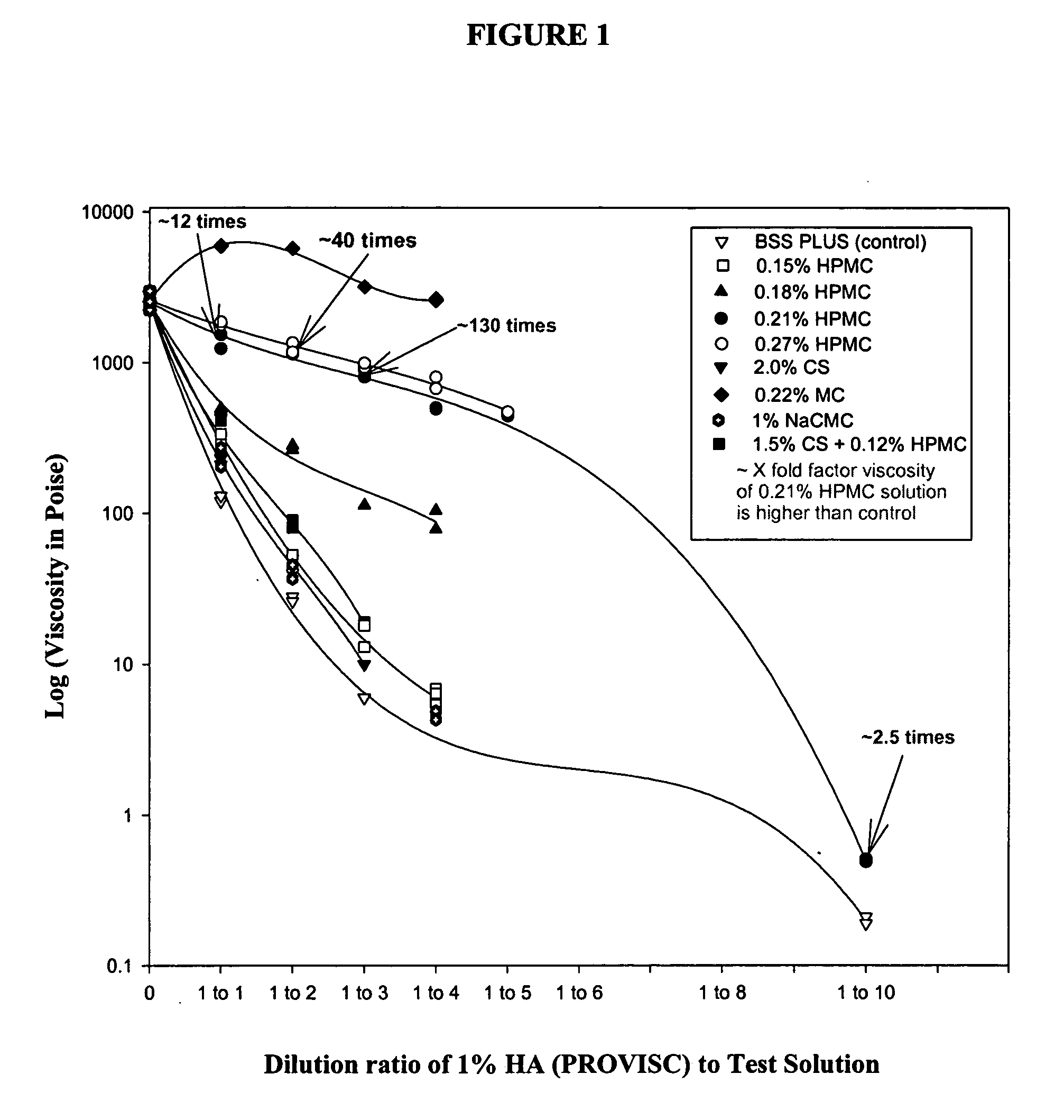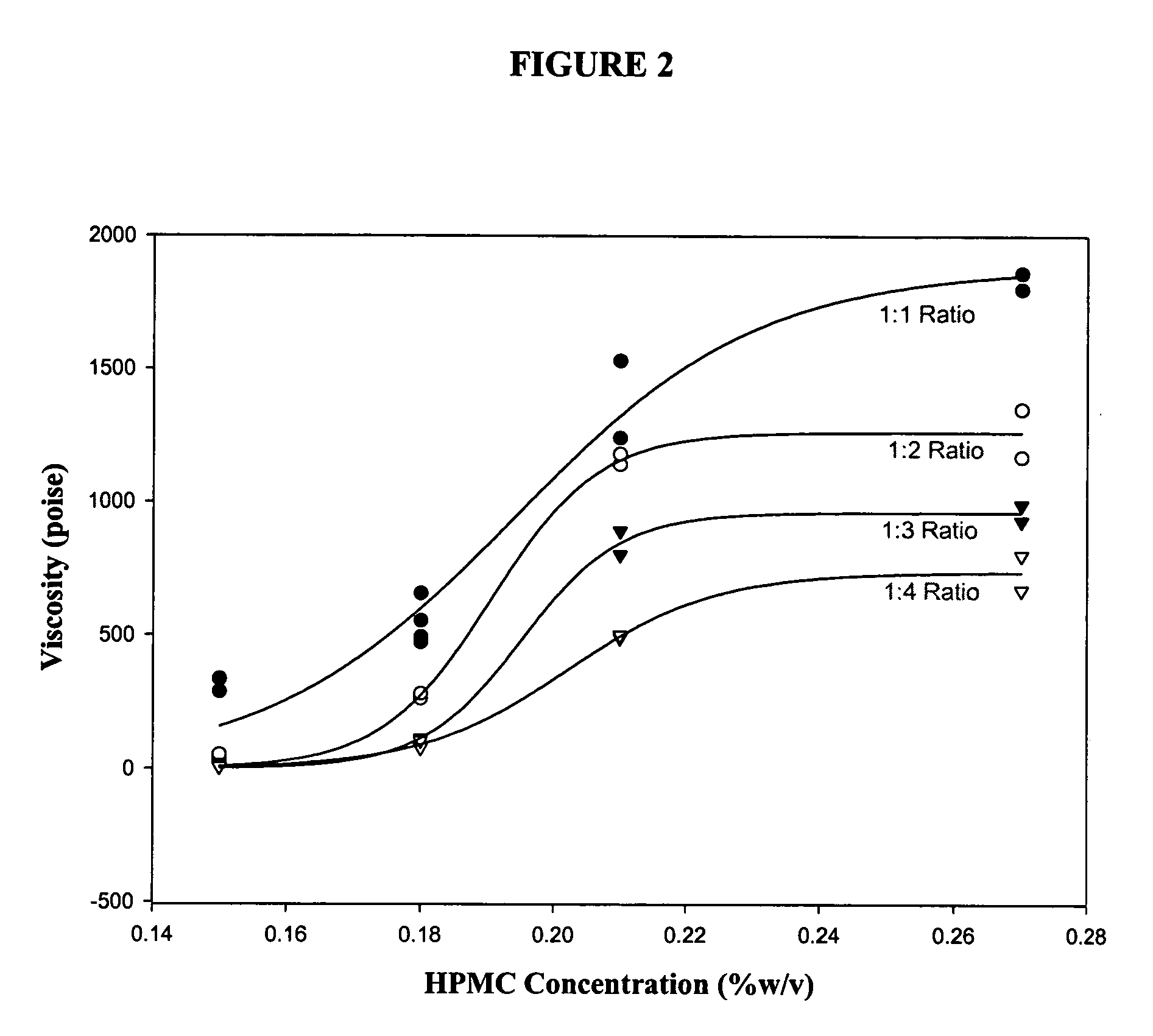Dilution resistant viscoelastic compositions
a technology of viscoelastic compositions and viscoelastic compositions, applied in the field of new products, can solve the problems of prone to accidental or premature aspiration, significant and/or irreversible damage to susceptible ocular tissues, adhesion to ocular tissues, etc., and achieve the effect of less cohesiveness, more viscosity, and increased resistance to dilution and viscosity loss
- Summary
- Abstract
- Description
- Claims
- Application Information
AI Technical Summary
Benefits of technology
Problems solved by technology
Method used
Image
Examples
example 1
[0025] A 0.4 mL aliquost of PROVISC or VISCOAT, as the case may be is placed in a 5 mL reaction vial (conical interior, covered with a flat bottom). To the viscoelastic, 5 microliters of Na fluorescein solution (25% w / v) is added for visualization of the viscoelastic. 0.6 mL of appropriate irrigating solution is then added to the above vial, using a micropipette. The irrigating solution in contact with the viscoelastic is then agitated to promote partial mixing by engaging the ultrasound on the phacoemulsification handpiece tip, and placing such tip in the irrigating solution, (expression of additional irrigating solution should be avoided by lowering the irrigating solution bottle to a height below the level of the reaction vial). The ultrasound mixing is continued for 20 seconds, while moving the phaco tip, to mix the solution with the viscoelastic, along with the dye. After mixing, the height of the irrigating solution bottle is raised and irrigation / aspiration of the colored vis...
example 2
[0029]
TABLE 2ComponentAmount (w / v %)FunctionHPMC [E4M from Dow0.1 to 0.3Rheology modifierChemical] (Molecularweight: 86,000)Sodium Chloride0.744Tonicity AgentPotassium Chloride0.0395Essential IonDibasic Sodium Phosphate0.0433Buffering Agent(Anhydrous)Sodium Bicarbonate0.219% + 10Physiological Bufferto 20% excessHydrochloric AcidAdjust PhPh AdjustSodium HydroxideAdjust PhPh AdjustWater for Injection100%Vehicle
[0030] The formulation described in Table 2 above may be prepared as follows: First, the water for Injection is brought close to boiling or at boiling. The HPMC is then slowly added to the water under continuous stirring to thoroughly disperse it in the water. Then the mixture is slowly allowed to cool, stirring continuously. Once at room temperature, the mixture should start clearing up. The mixture is then stored overnight at 4° to 8° C. in an appropriate container to fully hydrate the HPMC. The following day, the remaining ingredients are added to the HPMC solution, pH of the...
example 3
[0031]
TABLE 3ComponentAmount (w / v %)FunctionMC [A15C Premium0.1 to 0.3Rheology modifierfrom Dow Chemical](Molecular weight: 63,000)Sodium Chloride0.744Tonicity AgentPotassium Chloride0.0395Essential IonDibasic Sodium Phosphate0.0433Buffering Agent(Anhydrous)Sodium Bicarbonate0.219% + 10Physiological Bufferto 20% excessHydrochloric AcidAdjust PhPh AdjustSodium HydroxideAdjust PhPh AdjustWater for Injection100%Vehicle
[0032] The formulation described in Table 3 above may be prepared as follows: First, the water for Injection is brought close to boiling or at boiling. The MC is then slowly added to the water under continuous stirring to thoroughly disperse it in the water. Then the mixture is slowly allowed to cool, stirring continuously. Once at room temperature, the mixture should start clearing up. The mixture is then stored overnight at 4° to 8° C. in an appropriate container to fully hydrate the MC. The following day, the remaining ingredients are added to the MC solution, pH of th...
PUM
| Property | Measurement | Unit |
|---|---|---|
| molecular weight | aaaaa | aaaaa |
| average molecular weight | aaaaa | aaaaa |
| average molecular weight | aaaaa | aaaaa |
Abstract
Description
Claims
Application Information
 Login to View More
Login to View More - R&D
- Intellectual Property
- Life Sciences
- Materials
- Tech Scout
- Unparalleled Data Quality
- Higher Quality Content
- 60% Fewer Hallucinations
Browse by: Latest US Patents, China's latest patents, Technical Efficacy Thesaurus, Application Domain, Technology Topic, Popular Technical Reports.
© 2025 PatSnap. All rights reserved.Legal|Privacy policy|Modern Slavery Act Transparency Statement|Sitemap|About US| Contact US: help@patsnap.com


